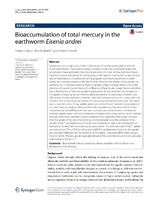| dc.contributor.author | Shirley Le Roux | |
| dc.contributor.author | Priscilla Baker | |
| dc.contributor.author | Andrew Crouch | |
| dc.date.accessioned | 2017-06-09T13:58:58Z | |
| dc.date.available | 2017-06-09T13:58:58Z | |
| dc.date.issued | 2016 | |
| dc.identifier.citation | Le Roux,S. (2016). Bioaccumulation of total mercury in the earthworm Eisenia andrei. SpringerPlus ,5:681 | en_US |
| dc.identifier.issn | 21931801 | |
| dc.identifier.uri | http://dx.doi.org/10.1186/s40064-016-2282-6 | |
| dc.identifier.uri | http://hdl.handle.net/10566/2949 | |
| dc.description.abstract | Earthworms are a major part of the total biomass of soil fauna and play a vital role
in soil maintenance. They process large amounts of plant and soil material and can
accumulate many pollutants that may be present in the soil. Earthworms have been
explored as bioaccumulators for many heavy metal species such as Pb, Cu and Zn but
limited information is available for mercury uptake and bioaccumulation in earth-
worms and very few report on the factors that influence the kinetics of Hg uptake by
earthworms. It is known however that the uptake of Hg is strongly influenced by the
presence of organic matter, hence the influence of ligands are a major factor contribut
-
ing to the kinetics of mercury uptake in biosystems. In this work we have focused on
the uptake of mercury by earthworms (
Eisenia andrei
) in the presence of humic acid
(HA) under varying physical conditions of pH and temperature, done to assess the role
of humic acid in the bioaccumulation of mercury by earthworms from soils. The study
was conducted over a 5-day uptake period and all earthworm samples were analysed
by direct mercury analysis. Mercury distribution profiles as a function of time, bioac-
cumulation factors (BAFs), first order rate constants and body burden constants for
mercury uptake under selected conditions of temperature, pH as well as via the dermal
and gut route were evaluated in one comprehensive approach. The results showed
that the uptake of Hg was influenced by pH, temperature and the presence of HA.
Uptake of Hg
2
+
was improved at low pH and temperature when the earthworms in
soil were in contact with a saturating aqueous phase. The total amount of Hg
2
+
uptake
decreased from 75 to 48
% as a function of pH. For earthworms in dry soil, the uptake
was strongly influenced by the presence of the ligand. Calculated BAF values ranged
from 0.1 to 0.8. Mercury uptake typically followed first order kinetics with rate constants
determined as 0.2 to 1
h
?
1
. | en_US |
| dc.language.iso | en | en_US |
| dc.publisher | SpringerOpen | |
| dc.rights | All the contents of this journal, except where otherwise noted, is licensed under a Creative Commons Attribution License | |
| dc.subject | Bioavailability | en_US |
| dc.subject | Bioaccumulation | en_US |
| dc.subject | Bioaccumulation factor | en_US |
| dc.subject | Humic acid | en_US |
| dc.subject | Earthworms | en_US |
| dc.subject | Soil | en_US |
| dc.subject | Mercury | en_US |
| dc.title | Bioaccumulation of total mercury in the earthworm Eisenia andrei | en_US |
| dc.type | Article | en_US |
| dc.description.accreditation | Scopus 2017 | |

